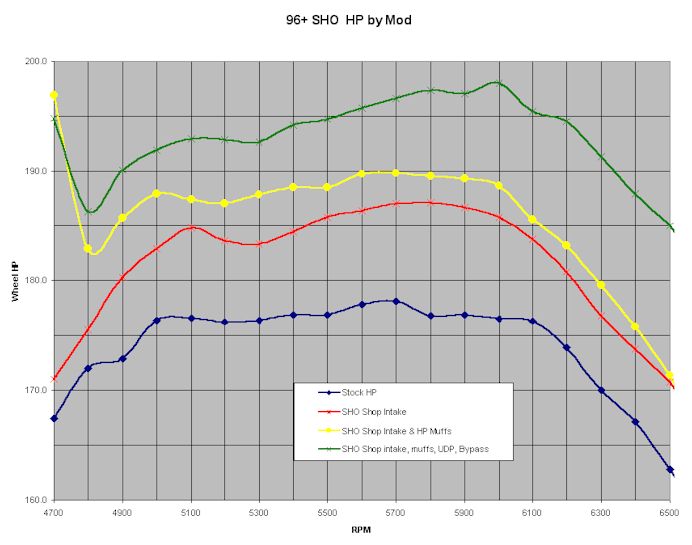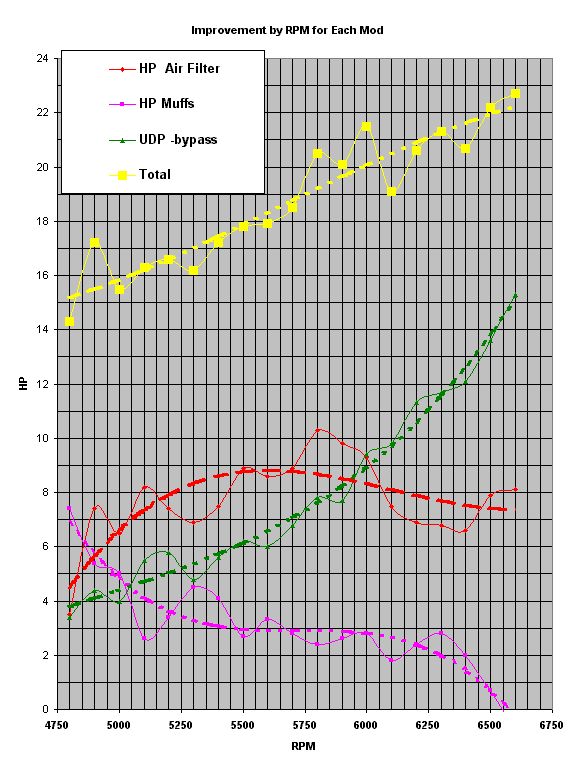

Thank to: Tim Wright
|
RPM |
Stock HP |
SHO Shop Intake |
SHO Shop Intake & HP Muffs |
SHO Shop intake, muffs, UDP, Bypass |
|
4700 |
167.5 |
171.0 |
196.9 |
194.8 |
|
4800 |
172.0 |
175.5 |
182.9 |
186.3 |
|
4900 |
172.9 |
180.3 |
185.7 |
190.1 |
|
5000 |
176.4 |
182.9 |
187.9 |
191.9 |
|
5100 |
176.6 |
184.8 |
187.4 |
192.9 |
|
5200 |
176.2 |
183.6 |
187.0 |
192.8 |
|
5300 |
176.4 |
183.3 |
187.8 |
192.6 |
|
5400 |
176.9 |
184.4 |
188.5 |
194.1 |
|
5500 |
176.9 |
185.8 |
188.5 |
194.7 |
|
5600 |
177.8 |
186.4 |
189.7 |
195.7 |
|
5700 |
178.1 |
187.0 |
189.8 |
196.6 |
|
5800 |
176.8 |
187.1 |
189.5 |
197.3 |
|
5900 |
176.9 |
186.7 |
189.3 |
197.0 |
|
6000 |
176.5 |
185.8 |
188.6 |
198.0 |
|
6100 |
176.3 |
183.8 |
185.6 |
195.4 |
|
6200 |
173.9 |
180.8 |
183.2 |
194.5 |
|
6300 |
170.0 |
176.8 |
179.6 |
191.3 |
|
6400 |
167.2 |
173.8 |
175.8 |
187.9 |
|
6500 |
162.8 |
170.7 |
171.4 |
185.0 |
|
6600 |
158.4 |
166.5 |
165.8 |
181.1 |
|
6700 |
177.3 |
|||
|
6800 |
170.4 |
|||
|
6900 |
164.8 |
|||
|
7000 |
136.6 |
The first and only fudge is the SHO Shop intake adjustment which is known to make 8 hp, actual tests for the green and blue columns were done with no intake filter (which made about 12 hp) and are adjusted –4 HP to simulate the effect of the SHO Shop intake alone.

The blue line indicates the stock condition, next the red line indicates the addition of the SHO Shop intake. Note that it helps in the entire range from 4700-6500 rpm. Some have questioned if a free flow air filter would help unless the factory air filter system was at capacity. This indicates a noticeable improvement even at mid range rpm. The graph may be indicating that above 6100 the restrictive exhaust begins to negate the advantage of the free flow intake.
The yellow line indicates both intake system change and the replacement of the factory mufflers with those of after-market free flow design. Note that most of the improvement is below 6100 when I believe other exhaust restrictions begin to choke off the exhaust flow. Vadim at the SHO shop has a theory that engines are more sensitive to intake restrictions than exhaust restrictions because the intake operates at a mild vacuum but the exhaust operates at a higher pressure, so in effect the exhaust is better able to force its way. Would the numbers be different if one first changed the mufflers then changed the intake? It could be, either way the combination of the two are worth 11 hp or a 1/10 of a second in the quarter mile.
The green line represents the 97 SHO with SHO Shop UDP (Under Drive Pulley), SHO Shop by-pass flex pipe which replaces the 3rd Cat. Also the Y pipe before the first two cats had a nasty bit of flash where the two pipes joined and this was cleaned up. The UDP are reportedly worth a constant 5 hp so anything in excess of that is attributable to the by-pass pipe, which opens up the "top end." The bypass pipe is reported to be worth 7 hp. Seven plus 5 is 12 but the average improvement is only 8 hp. Well hp is not necessary additive – the minimum improvement is 3.4 hp – the maximum improvement is 15.3 hp at 6600 rpm. I suspect the UDP may only be worth 3-5 hp depending on engine rpm and the bypass helps mostly at top end, as much as 10 hp at red line. One old time test for a crushed or blocked exhaust system is to rev an engine and watch the backpressure develop and start choking the engine. (intake vacuum will die because of exhaust pressure build up) From reliable sources I can report the by-pass pipe and UDP had a huge effect on the ability of the SHO to quickly build speed beyond 100 mph. One may not expect a total improvement of 23 hp to make a big difference in top speed but with a modest frontal area of the 96+ SHO and low C.d. acceleration above 100 mph is greatly improved.
Lets take a difference between each incremental improvement and then graph them.
|
RPM |
Stock HP |
SHO Shop Intake |
SHO Shop Intake & HP Muffs |
SHO Shop intake, muffs, UDP, Bypass |
SHO Shop Intake |
SHO Shop Intake & HP Muffs |
SHO Shop intake, muffs, UDP, Bypass |
Total |
|
4700 |
167.5 |
171.0 |
196.9 |
194.8 |
||||
|
4800 |
172.0 |
175.5 |
182.9 |
186.3 |
3.50 |
7.40 |
3.40 |
14.3 |
|
4900 |
172.9 |
180.3 |
185.7 |
190.1 |
7.40 |
5.40 |
4.40 |
17.2 |
|
5000 |
176.4 |
182.9 |
187.9 |
191.9 |
6.50 |
5.00 |
4.00 |
15.5 |
|
5100 |
176.6 |
184.8 |
187.4 |
192.9 |
8.20 |
2.60 |
5.50 |
16.3 |
|
5200 |
176.2 |
183.6 |
187.0 |
192.8 |
7.40 |
3.40 |
5.80 |
16.6 |
|
5300 |
176.4 |
183.3 |
187.8 |
192.6 |
6.90 |
4.50 |
4.80 |
16.2 |
|
5400 |
176.9 |
184.4 |
188.5 |
194.1 |
7.50 |
4.10 |
5.60 |
17.2 |
|
5500 |
176.9 |
185.8 |
188.5 |
194.7 |
8.90 |
2.70 |
6.20 |
17.8 |
|
5600 |
177.8 |
186.4 |
189.7 |
195.7 |
8.60 |
3.30 |
6.00 |
17.9 |
|
5700 |
178.1 |
187.0 |
189.8 |
196.6 |
8.90 |
2.80 |
6.80 |
18.5 |
|
5800 |
176.8 |
187.1 |
189.5 |
197.3 |
10.30 |
2.40 |
7.80 |
20.5 |
|
5900 |
176.9 |
186.7 |
189.3 |
197.0 |
9.80 |
2.60 |
7.70 |
20.1 |
|
6000 |
176.5 |
185.8 |
188.6 |
198.0 |
9.30 |
2.80 |
9.40 |
21.5 |
|
6100 |
176.3 |
183.8 |
185.6 |
195.4 |
7.50 |
1.80 |
9.80 |
19.1 |
|
6200 |
173.9 |
180.8 |
183.2 |
194.5 |
6.90 |
2.40 |
11.30 |
20.6 |
|
6300 |
170.0 |
176.8 |
179.6 |
191.3 |
6.80 |
2.80 |
11.70 |
21.3 |
|
6400 |
167.2 |
173.8 |
175.8 |
187.9 |
6.60 |
2.00 |
12.10 |
20.7 |
|
6500 |
162.8 |
170.7 |
171.4 |
185.0 |
7.90 |
0.70 |
13.60 |
22.2 |
|
6600 |
158.4 |
166.5 |
165.8 |
181.1 |
8.10 |
-0.70 |
15.30 |
22.7 |
|
6700 |
177.3 |
7.97 |
2.81 |
8.21 |
19.0 |
|||
|
6800 |
170.4 |
3.50 |
-0.70 |
3.40 |
14.30 |
|||
|
6900 |
164.8 |
10.3 |
7.4 |
15.3 |
22.7 |
|||
|
7000 |
136.6 |
One may argue from the chart that the SHO shop intake alone makes 8 hp, the performance mufflers 3 hp and the UDP 3.5 hp and the bypass pipe 4.5 more hp but this an inaccurate over simplification.
If we plot improvement for each modification by rpm and add trend lines important clues can be picked out of the data.

The Hi-Flow Intake (red line) from the SHO Shop works fine until 5800 when evidently the backpressure starts choking the engine. It helps some at low rpm but as one may intuitively expect it helps the most at higher rpm where the factory air filter is at capacity - until the exhaust reaches capacity.
Performance mufflers (purple line) help hp and torque mostly at low rpm as they help scavenge the cylinders better. Their contribution also levels off from 5500 to 6000 rpm because the upstream exhaust system is achieving full capacity becoming the controlling restriction.
The green lines representing both the UDP and by pass pipe can best be understood by breaking them into their elements. The UDP alone contribute 3-5 hp depending on engine rpm. Although in absolute terms their contribution may be small in relative terms their contribution is large as a percentage of total improvement at especially at lower rpm greatly helping off-line performance. In contrast the bypass pipe may not help at all below 5000 rpm but as every other modification starts to reach it’s peak and taper off the bypass pipe is the one obstacle choking off the engine and limiting performance. Removal of the third cat allows the engine to breathe above 5000 rpm, indeed up to 7000 rpm not only shifting the hp curve up put opening up the whole of the upper rpm torque curve. That is what the SHO was born to do. Notice that the maximum improvement is at 6600 rpm, the highest value for which we have good data, the best is yet higher. The shift of the hp curve and implied torque curve and now make late shifts much more feasible. With the by-pass flex pipe the V8 becomes a true 7000 rpm motor.
At each stage of modification the chip seems to adjust shift points for optimal performance. Sweet deal!
I don’t like to think of hp not being additive so much as this is a system and every improvement leaves the next impairment to discover and tune. Evaluated as a system (yellow lines), the cumulative improvement is almost linear: 15 hp at 4800 rpm, 23 hp at 6600 rpm and very predictable in between at least for the rpm when the secondaries are open.
Yet to be solved is the 96 chip mystery. 96 SHOs start with 10-13 more hp than 97-99 SHOs. I can not accept it is a change in cam, compression. or something mechanical. I have to think the engine was toned down in the chip. Consumer Reports bitched about an aggressive tip in and I suspect the corporate lawyers ever mindful of the Audi lawsuits concluded it would be prudent to castrate our chip. Currently the V8 SHO group is working on this problem and we hope to add another 13 wheel hp to the peak.
Add that 13 hp to 198 and we get 211 wheel hp or 264 gross hp without NOS, blower or so much as taking off a valve cover. The changes have no measurable effect on emissions, drive-ability, reliability and seem to only help gas mileage. The Ford warning admonishing owners not to use oil impregnated air filters has yet to cause one problem.
It has been a long time since we first played with mouse traps and replacement mufflers, it has taken so long to figure this out or cars are no longer in production.
The last question, what does it all cost?
|
Budget |
|
|
SHO Shop Air Box |
$249 |
|
Hi Flow Mufflers |
$120 |
|
UDP |
$249 |
|
Bypass Flex Pipe |
$119 |
|
Total |
$737 |